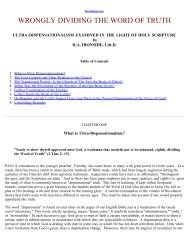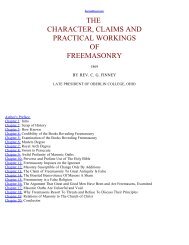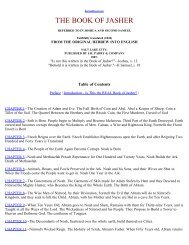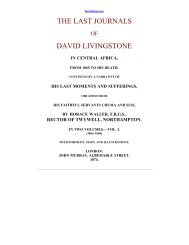Legends of Babylon and Egypt in Relation to Hebrew Tradition.pdf
Legends of Babylon and Egypt in Relation to Hebrew Tradition.pdf
Legends of Babylon and Egypt in Relation to Hebrew Tradition.pdf
Create successful ePaper yourself
Turn your PDF publications into a flip-book with our unique Google optimized e-Paper software.
eighteen milliards <strong>of</strong> <strong>to</strong>ns <strong>of</strong> water. See his work /The Irrigations <strong>of</strong> Mesopotamia/ (E. <strong>and</strong> F. N. Spon, 1911),<br />
/Geographical Journal/, Vol. XL, No. 2 (Aug., 1912), pp. 129 ff., <strong>and</strong> the articles <strong>in</strong> /The Near East/ cited on p. 97, n. 1,<br />
<strong>and</strong> p. 98, n. 2. Sir William Willcocks's volume <strong>and</strong> subsequent papers form the best <strong>in</strong>troduction <strong>to</strong> the study <strong>of</strong><br />
<strong>Babylon</strong>ian Deluge tradition on its material side.<br />
[3] Their works carried out on the Tigris were effective for irrigation; but the <strong>Babylon</strong>ians never succeeded <strong>in</strong><br />
controll<strong>in</strong>g its floods as they did those <strong>of</strong> the Euphrates. A massive earthen dam, the rema<strong>in</strong>s <strong>of</strong> which are still known<br />
as "Nimrod's Dam", was thrown across the Tigris above the po<strong>in</strong>t where it entered its delta; this served <strong>to</strong> turn the river<br />
over hard conglomerate rock <strong>and</strong> kept it at a high level so that it could irrigate the country on both banks. Above the<br />
dam were the heads <strong>of</strong> the later Nahrwân Canal, a great stream 400 ft. wide <strong>and</strong> 17 ft. deep, which supplied the<br />
country east <strong>of</strong> the river. The Nâr Sharri or "K<strong>in</strong>g's Canal", the Nahar Malkha <strong>of</strong> the Greeks <strong>and</strong> the Nahr el-Malik <strong>of</strong><br />
the Arabs, protected the right bank <strong>of</strong> the Tigris by its own high artificial banks, which can still be traced for hundreds<br />
<strong>of</strong> miles; but it <strong>to</strong>ok its supply from the Euphrates at Sippar, where the ground is some 25 ft. higher than on the Tigris.<br />
The Tigris usually flooded its left bank; it was the right bank which was protected, <strong>and</strong> a breach here meant disaster.<br />
Cf. Willcocks, op. cit., <strong>and</strong> /The Near East/, Sept. 29, 1916 (Vol. XI, No. 282), p. 522.<br />
It was only by constant <strong>and</strong> unremitt<strong>in</strong>g attention that disaster from flood could be averted; <strong>and</strong> the difficulties <strong>of</strong> the<br />
problem were <strong>and</strong> are <strong>in</strong>creased by the fact that the flood-water <strong>of</strong> the Mesopotamian rivers conta<strong>in</strong>s five times as<br />
much sediment as the Nile. In fact, one <strong>of</strong> the most press<strong>in</strong>g <strong>of</strong> the problems the Sumerian <strong>and</strong> early <strong>Babylon</strong>ian<br />
eng<strong>in</strong>eers had <strong>to</strong> solve was the keep<strong>in</strong>g <strong>of</strong> the canals free from silt.[1] What the floods, if left unchecked, may do <strong>in</strong><br />
Mesopotamia, is well illustrated by the decay <strong>of</strong> the ancient canal-system, which has been the immediate cause <strong>of</strong> the<br />
country's present state <strong>of</strong> sordid desolation. That the decay was gradual was not the fault <strong>of</strong> the rivers, but was due <strong>to</strong><br />
the sound pr<strong>in</strong>ciples on which the old system <strong>of</strong> control had been evolved through many centuries <strong>of</strong> labour. At the<br />
time <strong>of</strong> the Moslem conquest the system had already begun <strong>to</strong> fail. In the fifth century there had been bad floods; but<br />
worse came <strong>in</strong> A.D. 629, when both rivers burst their banks <strong>and</strong> played havoc with the dikes <strong>and</strong> embankments. It is<br />
related that the Sassanian k<strong>in</strong>g Parwiz, the contemporary <strong>of</strong> Mohammed, crucified <strong>in</strong> one day forty canal-workers at a<br />
certa<strong>in</strong> breach, <strong>and</strong> yet was unable <strong>to</strong> master the flood.[2] All repairs were suspended dur<strong>in</strong>g the anarchy <strong>of</strong> the<br />
Moslem <strong>in</strong>vasion. As a consequence the Tigris left its old bed for the Shatt el-Hai at Kût, <strong>and</strong> pour<strong>in</strong>g its own <strong>and</strong> its<br />
tributaries' waters <strong>in</strong><strong>to</strong> the Euphrates formed the Great Euphrates Swamp, two hundred miles long <strong>and</strong> fifty broad. But<br />
even then what was left <strong>of</strong> the old system was sufficient <strong>to</strong> support the splendour <strong>of</strong> the Eastern Caliphate.<br />
[1] Cf. /Letters <strong>of</strong> Hammurabi/, Vol. III, pp. xxxvi ff.; it was the duty <strong>of</strong> every village or <strong>to</strong>wn upon the banks <strong>of</strong> the<br />
ma<strong>in</strong> canals <strong>in</strong> <strong>Babylon</strong>ia <strong>to</strong> keep its own section clear <strong>of</strong> silt, <strong>and</strong> <strong>of</strong> course it was also responsible for its own smaller<br />
irrigation-channels. While the <strong>in</strong>vention <strong>of</strong> the system <strong>of</strong> bas<strong>in</strong>-irrigation was practically forced on <strong>Egypt</strong>, the<br />
extraord<strong>in</strong>ary fertility <strong>of</strong> <strong>Babylon</strong>ia was won <strong>in</strong> the teeth <strong>of</strong> nature by the system <strong>of</strong> perennial irrigation, or irrigation all<br />
the year round. In <strong>Babylon</strong>ia the water was led <strong>in</strong><strong>to</strong> small fields <strong>of</strong> two or three acres, while the Nile valley was<br />
irrigated <strong>in</strong> great bas<strong>in</strong>s each conta<strong>in</strong><strong>in</strong>g some thirty <strong>to</strong> forty thous<strong>and</strong> acres. The <strong>Babylon</strong>ian method gives far more<br />
pr<strong>of</strong>itable results, <strong>and</strong> Sir William Willcocks po<strong>in</strong>ts out that <strong>Egypt</strong> <strong>to</strong>-day is gradually ab<strong>and</strong>on<strong>in</strong>g its own system <strong>and</strong><br />
adopt<strong>in</strong>g that <strong>of</strong> its ancient rival; see /The Near East/, Sept. 29, 1916, p. 521.<br />
[2] See Le Strange, /The L<strong>and</strong>s <strong>of</strong> the Eastern Caliphate/, p. 27.<br />
The second great blow <strong>to</strong> the system followed the Mongol conquest, when the Nahrwân Canal, <strong>to</strong> the east <strong>of</strong> the Tigris,<br />
had its head swept away by flood <strong>and</strong> the area it had irrigated became desert. Then, <strong>in</strong> about the fifteenth century, the<br />
Tigris returned <strong>to</strong> its old course; the Shatt el-Hai shrank, <strong>and</strong> much <strong>of</strong> the Great Swamp dried up <strong>in</strong><strong>to</strong> the desert it is<br />
<strong>to</strong>-day.[1] Th<strong>in</strong>gs became worse dur<strong>in</strong>g the centuries <strong>of</strong> Turkish misrule. But the silt<strong>in</strong>g up <strong>of</strong> the Hillah, or ma<strong>in</strong>,<br />
branch <strong>of</strong> the Euphrates about 1865, <strong>and</strong> the transference <strong>of</strong> a great part <strong>of</strong> its stream <strong>in</strong><strong>to</strong> the H<strong>in</strong>dîyah Canal, caused<br />
even the Turks <strong>to</strong> take action. They constructed the old H<strong>in</strong>dîyah Barrage <strong>in</strong> 1890, but it gave way <strong>in</strong> 1903 <strong>and</strong> the<br />
state <strong>of</strong> th<strong>in</strong>gs was even worse than before; for the Hillah branch then dried entirely.[2]<br />
[1] This illustrates the damage the Tigris itself is capable <strong>of</strong> <strong>in</strong>flict<strong>in</strong>g on the country. It may be added that Sir William<br />
Willcocks proposes <strong>to</strong> control the Tigris floods by an escape <strong>in</strong><strong>to</strong> the Tharthâr depression, a great salt pan at the tail <strong>of</strong><br />
Wadi Tharthâr, which lies 14 ft. below sea level <strong>and</strong> is 200 ft. lower than the flood-level <strong>of</strong> the Tigris some thirty-two<br />
miles away. The escape would leave the Tigris <strong>to</strong> the S. <strong>of</strong> Sâmarra, the proposed Beled Barrage be<strong>in</strong>g built below it
















